Effect of Coir Fiber Reinforcement on Properties of Metakaolin-Based Geopolymer Composite
Abstract
:1. Introduction
Research Significance
2. Materials and Methods
2.1. Geopolymer Precursor Material
2.2. Alkaline Solution
2.3. Coir Fiber
2.4. Preparation of Samples
2.5. Physical and Mechanical Property Measurement of Samples
2.6. Ultrasonic Pulse Velocity (UPV) Measurements
2.7. Microstructural Characterization
3. Results and Discussion
3.1. Effect of Coir Fiber Addition on the Compressive Strength of Geopolymer Specimen
3.2. Effect of Coir Fiber Addition on the Flexural Strength of Geopolymer Specimen
3.3. Effect of Coir Fiber Addition on the Bulk Density of Geopolymer Specimen
3.4. Effect of Coir Fiber Addition on the Ultrasonic Pulse Velocity (UPV) of Geopolymer Specimens
3.5. Effect of Coir Fiber Addition on the Crystal Structure of Geopolymer Specimen
3.6. Effect of Coir Fiber Addition on Absorption Bands of Geopolymer Specimen
3.7. Effect of Coir Fiber Addition on the Microstructure of Geopolymer Specimen
3.8. Implications of the Current Study
4. Conclusions
- i.
- Increasing the weight percent of coir fibers in MK-based geopolymers from 0% to 2.0% led to a corresponding decrease in the bulk density of CFRMG composites from 2113 kg/m3 to 2045 kg/m3. The decreased bulk density will promote the ease of handling the CFRMG composites.
- ii.
- The geopolymer samples had UPV values varying from 2315 m/s to 2717 m/s, with the control sample giving the lowest value of UPV while the 0.5 wt % gave the highest value. The UPV result indicated a more homogeneous pore distribution within the 0.5 wt % CFRMG composite.
- iii.
- The addition of 0.5 wt % coir fibers in metakaolin-based geopolymers was most beneficial to the compressive strength development of CFRMG composites as this fiber content gave the highest compressive strength value of 21.25 N/mm2, which met the minimum compressive strength values of ASTM C216 and ASTM C62 for producing paving bricks and building bricks, respectively.
- iv.
- The optimum coir fiber weight percent that favored flexural strength values of CFRMG composites was 1.0% (10.39 N/mm2). At higher fiber content (1.5% and 2%), a weak composite interface was created due to increased fiber-to-fiber interaction, causing flexural strength values to decrease.
- v.
- Incorporating coir fibers in the matrices of metakaolin-based geopolymers did not change their crystal structures or result in new chemical bonds in the CFRMG composite structure.
5. Limitation and Future Research
Author Contributions
Funding
Institutional Review Board Statement
Informed Consent Statement
Data Availability Statement
Conflicts of Interest
References
- Korniejenko, K.; Frączek, M.; Pytlak, E.; Adamski, M. Mechanical properties of geopolymer composites reinforced with natural fibers. Procedia Eng. 2016, 151, 388–393. [Google Scholar] [CrossRef]
- Lach, M.; Hebdowska-Krupa, M.; Mierzwiński, D.; Korniejenko, K. Mechanical properties of geopolymers reinforced with carbon and aramid long fibers. IOP Conf. Ser. Mater. Sci. Eng. 2019, 706, 012011. [Google Scholar] [CrossRef]
- Yan, S.; Zhang, F.; Li, H.; Gao, B.; Xing, P.; He, P. Synthesis and mechanical properties of lightweight hybrid geopolymer foam reinforced with carbon nanotubes. Int. J. Appl. Ceram. Technol. 2020, 17, 2335–2345. [Google Scholar] [CrossRef]
- Zhang, X.; Bai, C.; Qiao, Y.; Wang, X.; Jia, D.; Li, H.; Colombo, P. Porous geopolymer composites: A review. Compos. Part A 2021, 150, 106629. [Google Scholar] [CrossRef]
- Ahmad, W.; Khan, M.; Smarzewski, P. Effect of Short Fiber Reinforcements on Fracture Performance of Cement-Based Materials: A Systematic Review Approach. Materials 2021, 14, 1745. [Google Scholar] [CrossRef]
- Korniejenko, K.; Figiela, B.; Miernik, K.; Ziejewska, C.; Marczyk, J.; Hebda, M.; Cheng, A.; Lin, W.T. Mechanical and Fracture Properties of Long Fiber Reinforced Geopolymer Composites. Materials 2021, 14, 5183. [Google Scholar] [CrossRef]
- Mahamat, A.A.; Obianyo, I.; Ngayakamo, B.; Bih, L.N.; Ayeni, O.; Azeko, S.T.; Savastano, H. Alkali activation of compacted termite mound soil for eco-friendly construction materials. Heliyon 2021, 7, e06597. [Google Scholar] [CrossRef]
- Bih, L.N.; Mahamat, A.A.; Bidossessi, J.H.; Onwualu, A.P.; Boakye, E. The effect of polymer waste addition on the compressive strength and water absorption of geopolymer ceramics. Appl. Sci. 2021, 11, 3540. [Google Scholar] [CrossRef]
- Bih, N.L.; Mahamat, A.A.; Chinweze, C.; Ayeni, O.; Bidossessi, H.J.; Onwualu, P.A.; Boakye, E.E. The effect of bone ash on the physio-chemical and mechanical properties of clay ceramic bricks. Buildings 2022, 12, 336. [Google Scholar] [CrossRef]
- Alomayri, T.; Shaikh, F.U.A.; Low, I.M. Characterisation of cotton fiber-reinforced geopolymer composites. Compos. Part B Eng. 2013, 50, 1–6. [Google Scholar] [CrossRef] [Green Version]
- Silva, G.; Kim, S.; Aguilar, R.; Nakamatsu, J. Natural fibers as reinforcement additives for geopolymers—A review of potential eco-friendly applications to the construction industry. Sustain. Mater. Technol. 2020, 23, e00132. [Google Scholar] [CrossRef]
- Živica, V.; Palou, M.T.; Križma, M. Geopolymer cement, and their properties: A review. Build. Res. J. 2014, 61, 85–100. [Google Scholar] [CrossRef] [Green Version]
- Samal, S.; Blanco, I. An Application Review of Fiber-Reinforced Geopolymer Composite. Fibers 2021, 9, 23. [Google Scholar] [CrossRef]
- Ayeni, O.; Onwualu, A.P.; Boakye, E. Characterization and mechanical performance of metakaolin-based geopolymer for sustainable building applications. Constr. Build. Mater. 2021, 272, 121938. [Google Scholar] [CrossRef]
- Ranjbar, N.; Zhang, M. Fiber-reinforced geopolymer composites: A review. Cem. Concr. Compos. 2020, 107, 103498. [Google Scholar] [CrossRef]
- Korniejenko, K.; Lin, W.; Šimonová, S. Mechanical Properties of Short Polymer Fiber-Reinforced Geopolymer Composites. J. Compos. Sci. 2020, 4, 128. [Google Scholar] [CrossRef]
- Sheha, H.K.; Eisa, A.S.; Wahba, A.M. Mechanical properties of fly ash-based geopolymer concrete with full and partial cement replacement. Constr. Build. Mater. 2016, 126, 560–565. [Google Scholar] [CrossRef]
- Ranjbar, N.; Talebian, S.; Mehrali, M.; Kuenzel, C.; Cornelis, M.H.S.; Jumaat, M.Z. Mechanisms of interfacial bond in steel and polypropylene fiber reinforced geopolymer composites. Compos. Sci. Technol. 2016, 122, 73–81. [Google Scholar] [CrossRef]
- Wongsa, A.; Kunthawatwong, R.; Naenudon, S.; Sata, V.; Chindaprasirt, P. Natural fiber reinforced high calcium fly ash geopolymer mortar. Construct. Build. Mater. 2020, 241, 118143. [Google Scholar] [CrossRef]
- Farhan, K.Z.; Johari, M.A.M.; Demirboga, R. Impact of fiber reinforcements on properties of geopolymer composites: A review. J. Build. Eng. 2021, 44, 102628. [Google Scholar] [CrossRef]
- Correia, E.; Torres, S.; Alexandre, M.; Gomes, K.; Barbosa, N.; Barros, S. Mechanical performance of natural fibers reinforced Geopolymer composites. Mater. Sci. Forum 2013, 758, 139–145. [Google Scholar] [CrossRef]
- Silva, G.; Kim, S.; Bertolotti, B.; Nakamatsu, J.; Aguilar, R. Optimization of a reinforced geopolymer composite using natural fibers and construction wastes. Constr. Build. Mater. 2020, 258, 119697. [Google Scholar] [CrossRef]
- Alomayri, T.; Shaikh, F.; Low, I. Thermal and mechanical properties of cotton fabric reinforced geopolymer composites. J. Mater. Sci. 2013, 48, 6746–6752. [Google Scholar] [CrossRef]
- Koohestani, B.; Darbannt, A.K.; Mokhtari, P.; Yilmaz, E.; Darezereshki, E. Comparison of different natural fiber treatment: A literature review. Int. J. Environ. Sci. Technol. 2019, 16, 629–642. [Google Scholar] [CrossRef]
- Kumar, D.A.; Naidu, A.L. A study on different chemical treatments for Natural Fiber reinforced composites. Int. J. Mech. Prod. 2018, 8, 143–152. [Google Scholar]
- Alzeer, M.; MacKenzie, K. Synthesis and mechanical properties of novel composites of inorganic polymers (geopolymers) with unidirectional natural flax fibers (phormium tenax). Appl. Clay Sci. 2013, 75, 148–152. [Google Scholar] [CrossRef]
- Chen, R.; Ahmari, S.; Zhang, L. Utilization of sweet sorghum fiber to reinforce fly ash-based geopolymer. J. Mater. Sci. 2014, 49, 2548–2558. [Google Scholar] [CrossRef]
- Ribeiro, R.A.S.; Ribeiro, M.G.S.; Sankar, K.; Kriven, W.M. Geopolymer-bamboo composite—A novel sustainable construction material. Construct. Build. Mater. 2016, 123, 501–507. [Google Scholar] [CrossRef]
- Korniejenko, K.; Łach, M.; Hebdowska-Krupa, M.; Mikuła, J. The mechanical properties of flax and hemp fibers reinforced geopolymer composites. IOP Conf. Ser. Mater. Sci. Eng. 2018, 379, 01202. [Google Scholar] [CrossRef]
- Silva, G.; Kim, S.; Castañeda, A.; Donayre, R.; Nakamatsu, J.; Aguilar, R.; Mikuła, J. A comparative study of linen (flax) fibers as reinforcement of fly ash and clay brick powder-based geopolymers. IOP Conf. Ser. Mater. Sci. Eng. 2018, 416, 012107. [Google Scholar] [CrossRef]
- Furtos, G.; Silaghi-Dumitrescu, L.; Pascuta, P.; Sarosi, C.; Korniejenko, K. Mechanical Properties of Wood Fiber Reinforced Geopolymer Composites with Sand Addition. J. Nat. Fibers 2019, 18, 285–296. [Google Scholar] [CrossRef]
- Hassan, F.K.M.; Horvath, P.G.; Koczan, Z.; Alpar, T. Thermo-mechanical properties of pre-treated coir fiber and fibrous chips reinforced multilayered composites. Sci. Rep. 2021, 11, 3618. [Google Scholar] [CrossRef] [PubMed]
- Van Dam, J.E.G.; Van den Oever, M.J.A.; Keijsers, E. Production process for high-density performance binderless boards from whole coconut husk. Ind. Crop. Prod. 2004, 20, 97–101. [Google Scholar] [CrossRef]
- Yan, L.; Kasal, B.; Huang, L. A review of recent research on the use of cellulosic fibers, their fiber fabric reinforced cementitious, geo-polymer, and polymer composites in civil engineering. Compos. B Eng. 2016, 92, 94–132. [Google Scholar] [CrossRef]
- How Products are Made. Available online: http://www.madehow.com/Volume-6/Coir.html (accessed on 3 May 2022).
- Zulfiati, R.; Saloma; Idris, Y. The nature of coconut fiber fly ash-based mechanical geopolymer. IOP Conf. Ser. Mater. Sci. Eng. 2020, 807, 012041. [Google Scholar] [CrossRef]
- Da Luz, F.S.; Ramos, F.J.; Nascimento, L.F.; Figueiredo, A.B.; Monteiro, S.N. Critical length and interfacial strength of PALF and coir fiber incorporated in epoxy resin matrix. J. Mater. Res. Technol. 2018, 7, 528–534. [Google Scholar] [CrossRef]
- Islam, M.N.; Haque, M.M.; Huque, M.M. Mechanical and morphological properties of chemically treated coir-filled polypropylene composites. Ind. Eng. Chem. Res. 2009, 48, 10491–10497. [Google Scholar] [CrossRef]
- Adeniyi, A.G.; Onifade, D.V.; Ighalo, J.O. A review of coir fiber-reinforced polymer composites. Compos. Part B 2019, 176, 107305. [Google Scholar] [CrossRef]
- Verma, D.; Gope, P. The use of coir/coconut fibers as reinforcements in composites. In Biofiber Reinforcements in Composite Materials; Elsevier: Amsterdam, The Netherlands, 2015; pp. 285–319. [Google Scholar]
- Dong, Y.; Ghataura, A.; Takagi, H.; Haroosh, H.J.; Nakagaito, A.N.; Lau, K.-T. Polylactic acid (PLA) biocomposites reinforced with coir fibers: Evaluation of mechanical performance and multifunctional properties. Compos. Appl. Sci. Manuf. 2014, 63, 76–84. [Google Scholar] [CrossRef] [Green Version]
- Mir, S.S.; Nafsin, N.; Hasan, M.; Hasan, N.; Hassan, A. Improvement of physico-mechanical properties of coir-polypropylene bio-composites by fiber chemical treatment. Mater. Des. 2013, 52, 251–257. [Google Scholar] [CrossRef]
- Priya, N.A.S.; Raju, P.V.; Naveen, P. Experimental testing of polymer reinforced with coconut coir fiber composites. Int. J. Emerg. Technol. Adv. Eng. 2014, 4, 453–460. [Google Scholar]
- Zainudin, E.; Yan, L.H.; Haniffah, W.; Jawaid, M.; Alothman, O.Y. Effect of coir fiber loading on mechanical and morphological properties of oil palm fibers reinforced polypropylene composites. Polym. Compos. 2014, 35, 1418–1425. [Google Scholar] [CrossRef]
- Kochova, K.; Gauvin, F.; Schollbach, K.; Brouwers, H.J.H. Using alternative waste coir fibers as a reinforcement in cement-fiber composite. Constr. Build. Mater. 2020, 231, 117121. [Google Scholar] [CrossRef]
- Yan, L.; Su, S.; Chouw, N. Microstructure, flexural properties and durability of coir fiber reinforced concrete beams externally strengthened with flax FRP composites. Compos. B Eng. 2015, 80, 343–354. [Google Scholar] [CrossRef]
- Ahmed, A.S.; Salahudeen, N.; Ajinomoh, C.S.; Hamza, H.; Ohikere, A. Studies on Mineral and Chemical Characteristics of Pindiga Bentonitic Clay. Pet. Technol. Dev. J. 2012, 2, 55–62. [Google Scholar]
- Salahudeen, N.; Ahmed, A.S.; Ajinomoh, C.S.; Hamza, H. Surface Area Enhancement of Pindiga Bentonitic Clay for Usage as Catalyst Support. Pet. Technol. Dev. J. 2012, 2, 65–73. [Google Scholar]
- Satyanarayana, K.G.; Kulkarni, A.G.; Rohatgi, P.K. Structure and properties of coir fibers. Proc. Indian Acad. Sci. 1981, 4, 419–436. [Google Scholar] [CrossRef]
- Ramakrishna, G.; Sundararajan, T. Studies on the durability of natural fibers and the effect of corroded fibers on the strength of mortar. Cem. Concr. Compos. 2005, 27, 547–553. [Google Scholar] [CrossRef]
- Satyanarayana, K.G.; Sukumaran, K.; Mukherjee, P.S.; Pavittran, C.; Pillai, S.G.K. Natural fiber-polymer composites. Cem. Concr. Compos. 1980, 12, 117–136. [Google Scholar] [CrossRef]
- Sabinesh, S.; Renald, C.J.T.; Sathish, S. Investigation on Tensile and Flexural Properties of Coir Fiber Reinforced Isophthalic Polyester Composites. Int. J. Curr. Eng. Technol. 2014, 2, 213–219. [Google Scholar] [CrossRef]
- Tiwari, N.; Satyam, N. An Experimental Study on the Behavior of Lime and Silica Fume Treated Coir Geotextile Reinforced Expansive Soil Subgrade. Eng. Sci. Technol. Int. J. 2019, 23, 1214–1222. [Google Scholar] [CrossRef]
- Tiwari, N.; Satyam, N.; Puppala, A.J. Strength and Durability Assessment of Expansive Soil Stabilized with Recycled Ash and Natural Fibers. J. Transp. Geotech. 2021, 29, 100556. [Google Scholar] [CrossRef]
- Tiwari, N.; Satyam, N.; Patva, J. Experimental Study on the Swelling Behavior of Expansive Soil Reinforced with Coir Geotextile. In Proceedings of the Indian Geotechnical Conference 2019; Patel, S., Solanki, C.H., Reddy, K.R., Shukla, S.K., Eds.; Springer: Singapore, 2021; Chapter 11; ISBN 978-981-33-6563-6. [Google Scholar] [CrossRef]
- Sangian, H.F.; Khristian, J.; Rahma, S.; Dewi, H.K.; Puspasari, D.A.; Agnesty, S.Y.; Gunawan, S.; Widjaja, A. Preparation of reducing sugar hydrolyzed from lignin coconut coir dust pretreated by the recycled ionic liquid [mmim][dmp] and combination with alkaline. Bull. Chem. React. Eng. Catal. 2015, 10910, 8–22. [Google Scholar] [CrossRef] [Green Version]
- Ramakrishna, G.; Sundararajan, T. Impact strength of a few natural fibers reinforced cement mortar slabs: A comparative study. Cem. Concr. Compos. 2005, 27, 547–553. [Google Scholar] [CrossRef]
- Ali, M. Natural fibers as construction materials. J. Civ. Eng. Constr. Technol. 2012, 3, 80–89. [Google Scholar]
- ASTM C109; Standard Test Method for Compressive Strength of Hydraulic Cement Mortars (Using 2-In. or [50-mm] Cube Specimens). ASTM International: West Conshohocken, PA, USA, 2016.
- ASTM C293; Standard Test Method for Flexural Strength of Concrete (Using Simple Beam with Center-Point Loading). ASTM International: West Conshohocken, PA, USA, 2016.
- ASTM C597-02; Standard Test Method for Pulse Velocity through Concrete. ASTM International: West Conshohocken, PA, USA, 2017.
- ASTM C216; Standard Specification for Facing Brick. ASTM International: West Conshohocken, PA, USA, 2017.
- Yang, J.; Du, Q.; Bao, Y. Concrete with recycled concrete aggregate and crushed clay bricks. Constr. Build. Mater. 2011, 25, 1935–1945. [Google Scholar] [CrossRef]
- ASTM C62; Standard Specification for Building Brick (Solid Masonry Units Made from Clay or Shale). ASTM International: West Conshohocken, PA, USA, 2017.
- Abdullah, A.; Hussin, K.; Bnhussain, M.; Ismail, K.N.; Ibrahim, W.M.W. Mechanism and Chemical Reaction of Fly Ash. Int. J. Pure Appl. Sci. Technol. 2011, 6, 35–44. [Google Scholar]
- Berzins, A.; Morozovs, A.; Gross, U.; Iejavs, J. Mechanical properties of wood-geopolymer composite. In Proceedings of the 16th International Scientific Conference Engineering for Rural Development, Jelgava, Latvia, 24–26 May 2017. [Google Scholar]
- Hedjazi, S.; Castillo, D. Relationship among compressive strength and UPV of concrete reinforced with different types of fibers. Heliyon 2020, 6, e03646. [Google Scholar] [CrossRef]
- Maras, M.M.; Kose, M.M. Mechanical and microstructural properties of polypropylene fiber-reinforced geopolymer composites. J. Fiber Sci. Technol. 2019, 75, 35–46. [Google Scholar] [CrossRef] [Green Version]
- Wongsa, A.; Zaetang, Y.; Sata, V.; Chindaprasirt, P. Properties of lightweight fly ash geopolymer concrete containing bottom ash as aggregate. Constr. Build. Mater. 2016, 111, 637–643. [Google Scholar] [CrossRef]
- Ghosh, R.; Sagar, S.P.; Kumar, A.; Gupta, S.K.; Kumar, S. Estimation of geopolymer concrete strength from ultrasonic pulse velocity (UPV) using high power pulser. J. Build. Eng. 2018, 16, 39–44. [Google Scholar] [CrossRef]
- Shankar, S.; Joshi, H.R. Comparison of Concrete Properties determined by Destructive and Non-Destructive Tests. J. Inst. Eng. 2014, 10, 130–139. [Google Scholar] [CrossRef]
- Mejía de Gutiérrez, O.; Torres, J.; Vizcayno, C.; Castello, R. Influence of the calcination temperature of kaolin on the mechanical properties of mortars and concretes containing metakaolin. Clay Miner. 2008, 43, 183. [Google Scholar] [CrossRef] [Green Version]
- Salahudeen, N.; Ahmed, A.S.; Al-Muhtaseb, A.H.; Dauda, M.; Waziri, S.M.; Jibril, B.Y. Synthesis and characterization of micro-sized silica from Kankara Kaolin. J. Eng. Res. 2014, 19, 27–32. [Google Scholar]
- Mahamat, A.A.; Bih, L.N.; Ayeni, O.; Azikiwe, A.P.; Savastano, H. Development of sustainable and eco-friendly materials from termite hill soil stabilized with cement for low-cost housing in chad. Buildings 2021, 11, 86. [Google Scholar] [CrossRef]
- Obada, D.O.; Dodoo-arhin, D.; Dauda, M.; Ana, F.O.; Ahmed, A.S.; Ajayi, O.A. Potentials of fabricating porous ceramic bodies from kaolin for catalytic substrate applications. Appl. Clay Sci. 2016, 132, 194–204. [Google Scholar] [CrossRef]
- Tchadjié, L.N. Potential of using granite waste as raw material for geopolymer synthesis. Ceram. Int. 2016, 42, 3046–3055. [Google Scholar] [CrossRef]
- Yan, L.; Chouwc, N.; Huangd, L.; Kasala, B. Effect of alkali treatment on microstructure and mechanical properties of coir fibers, coir fiber-reinforced-polymer composites and reinforced-cementitious composites. Constr. Build. Mater. 2016, 112, 168–182. [Google Scholar] [CrossRef]
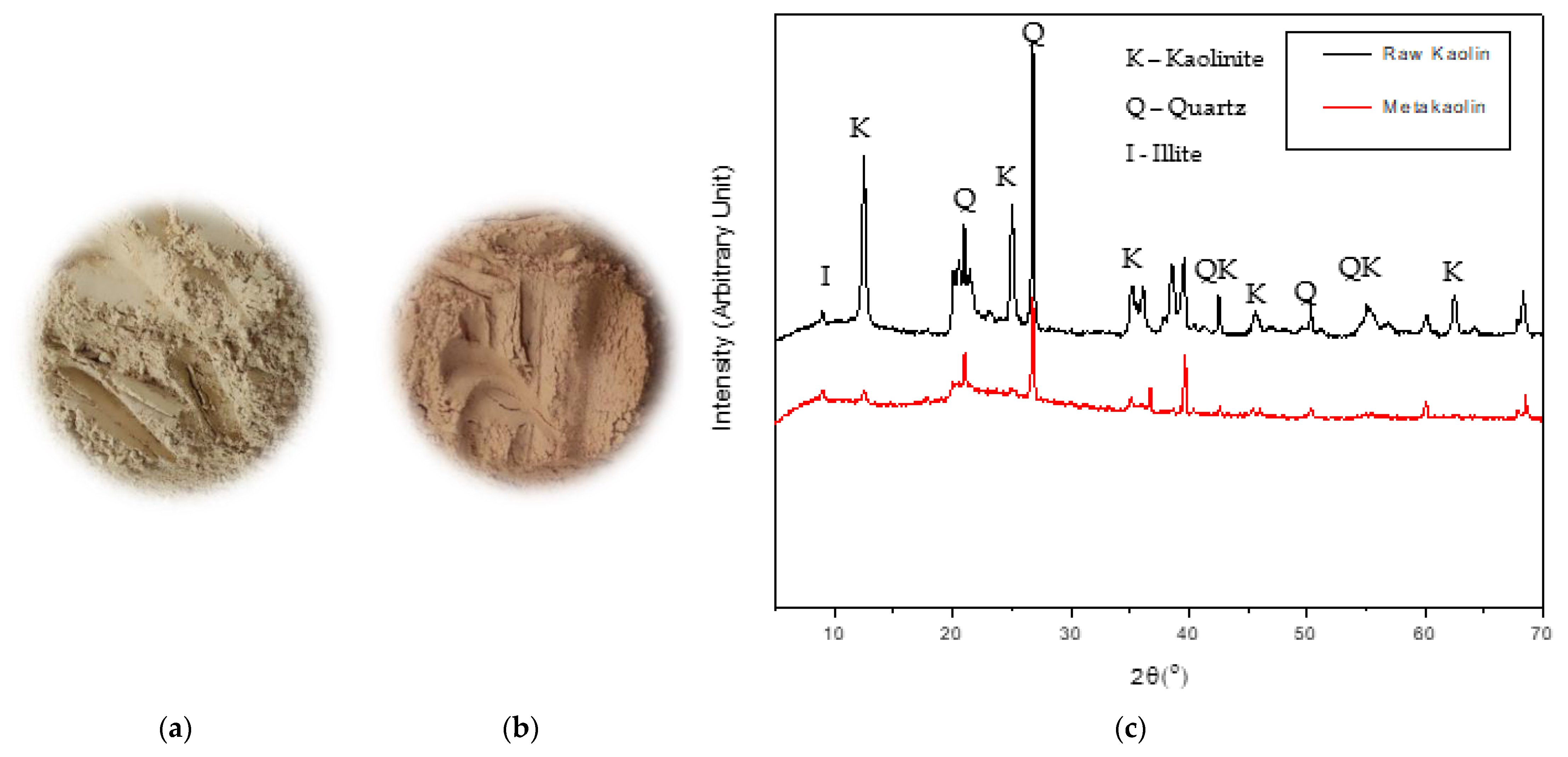
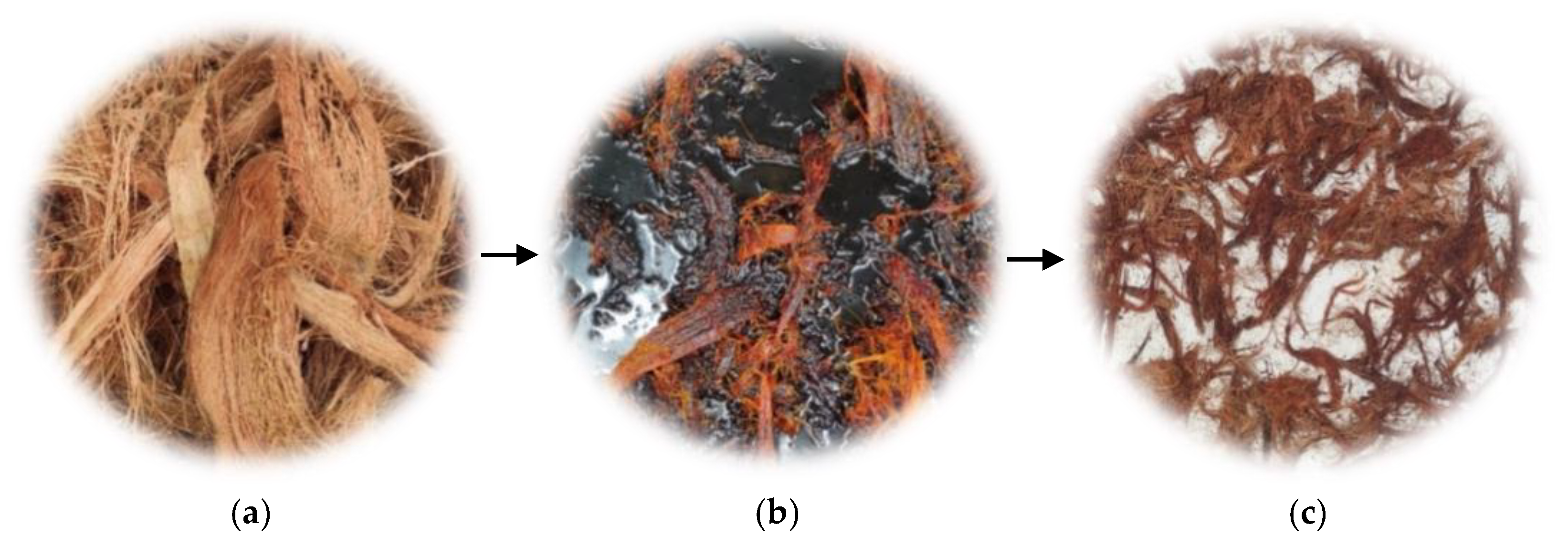
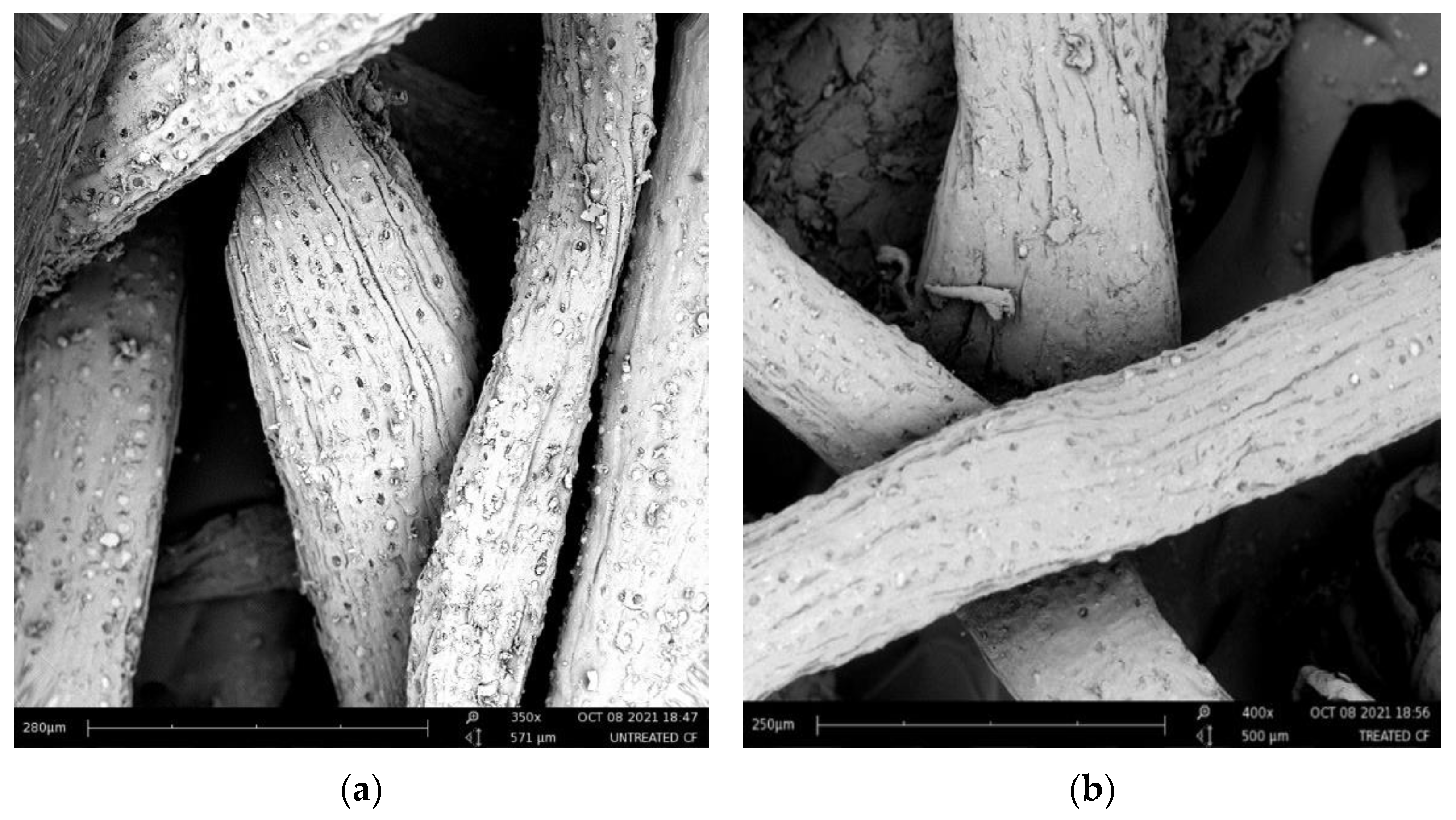

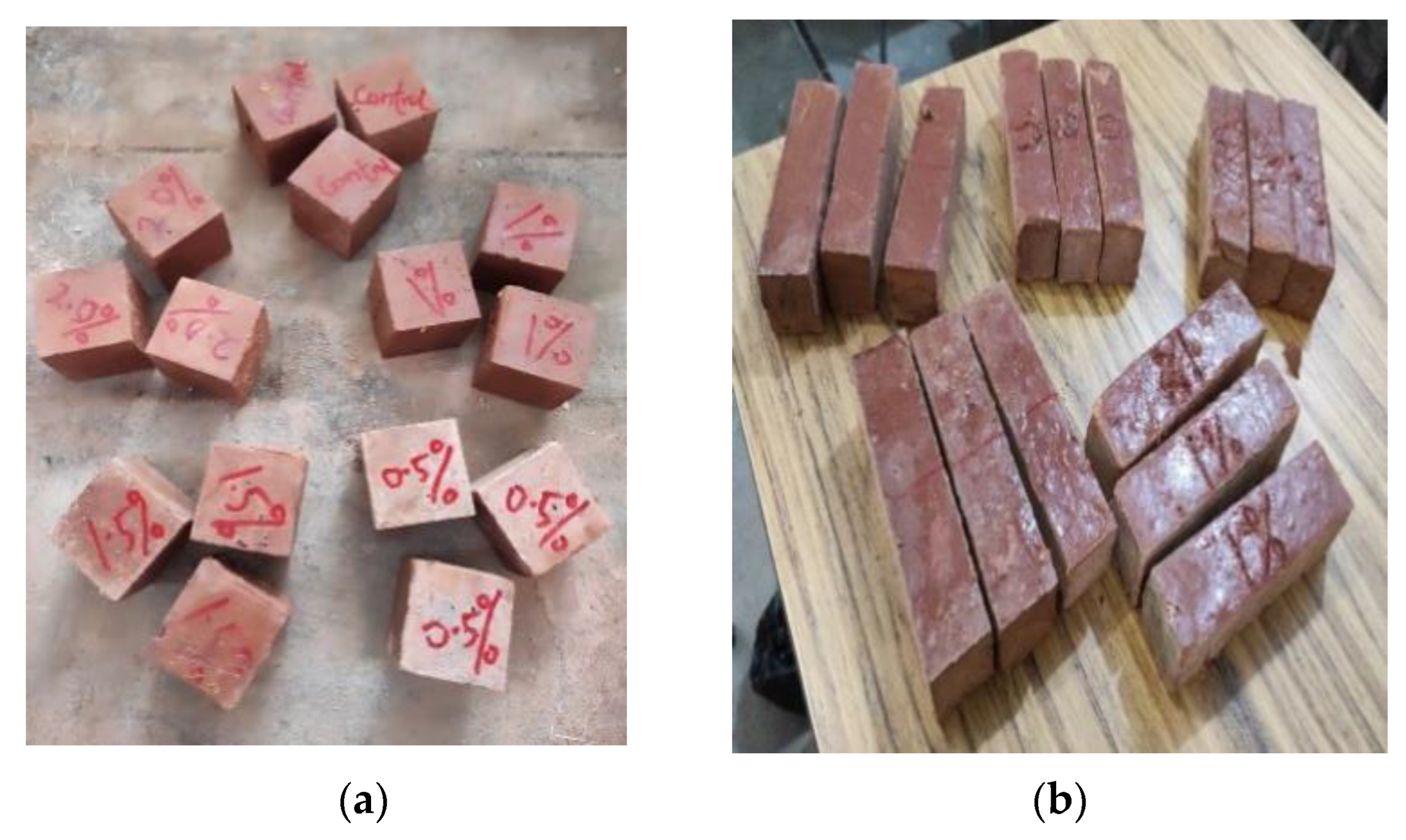
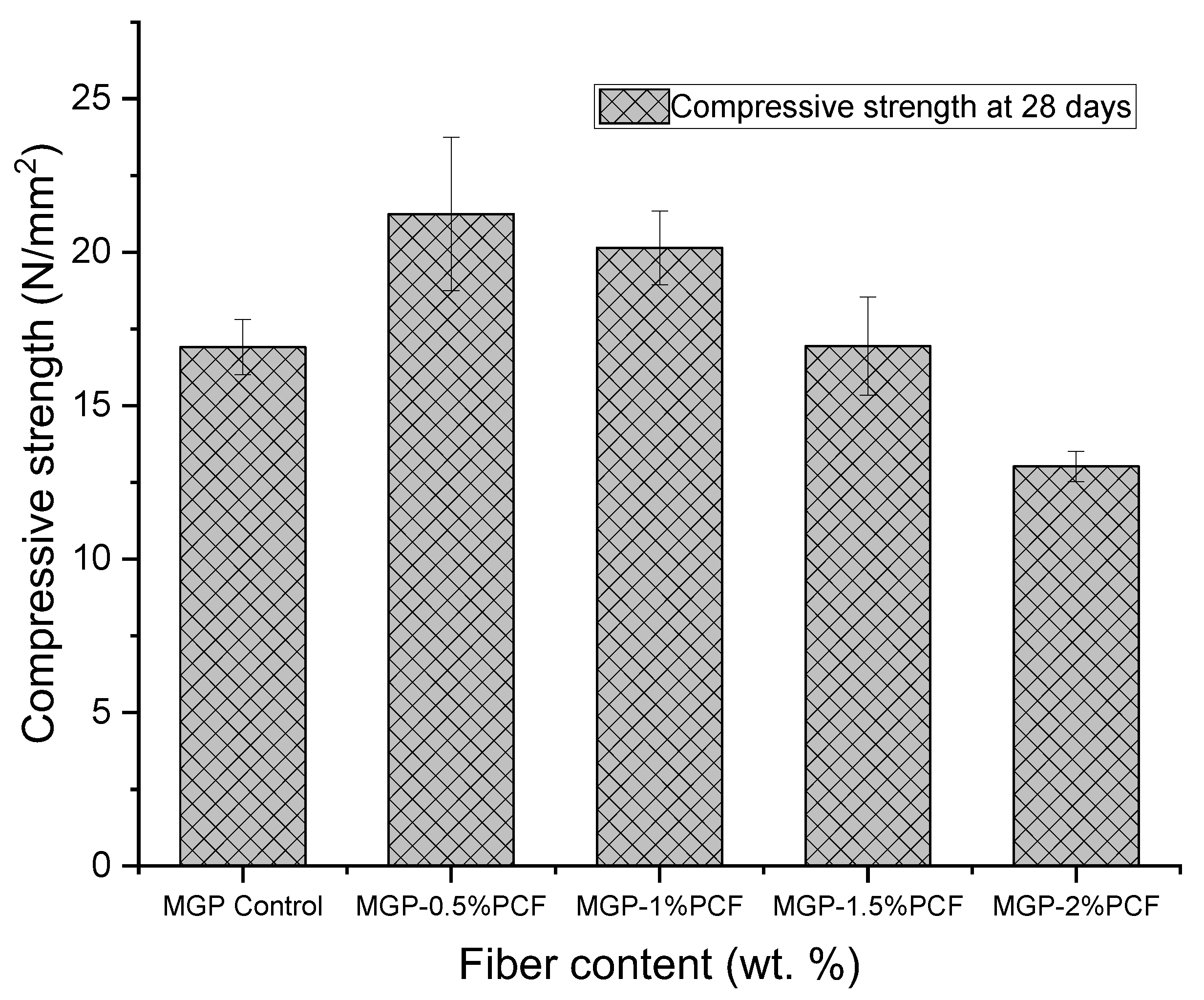
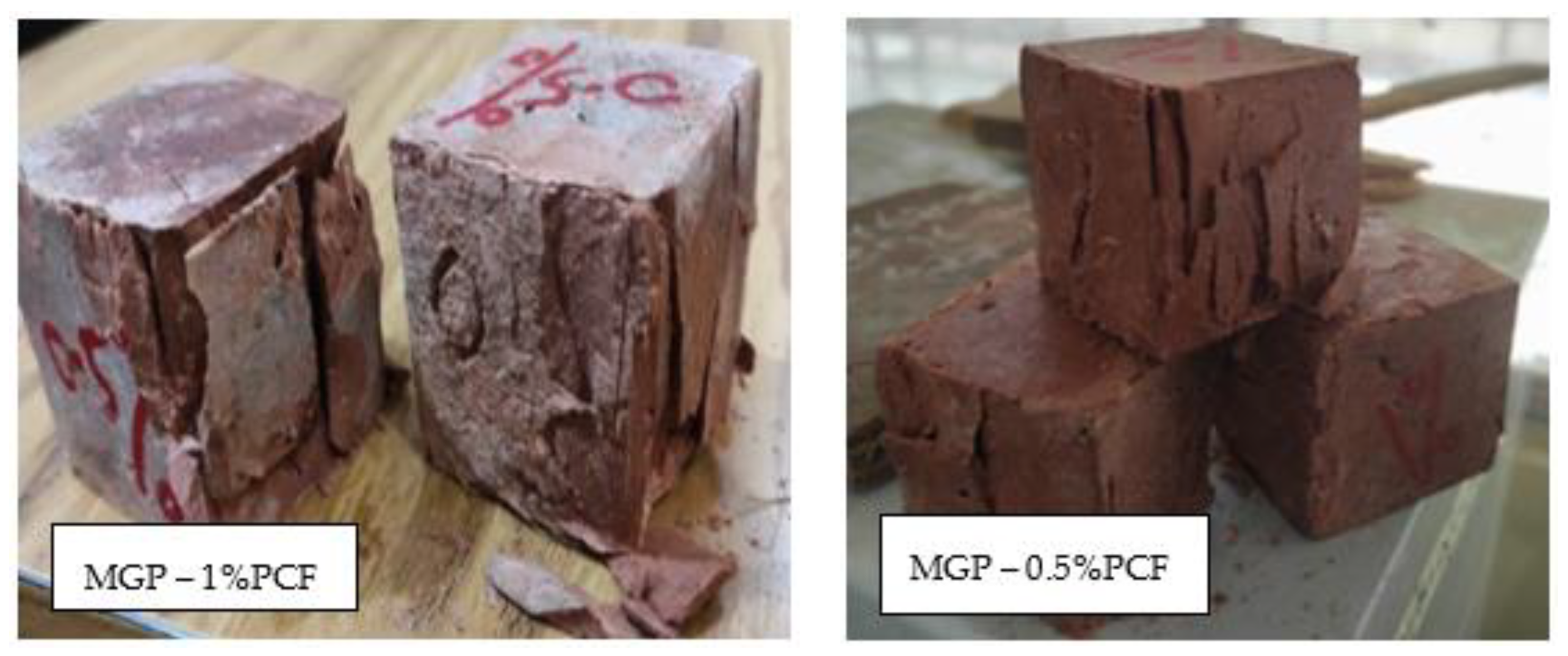

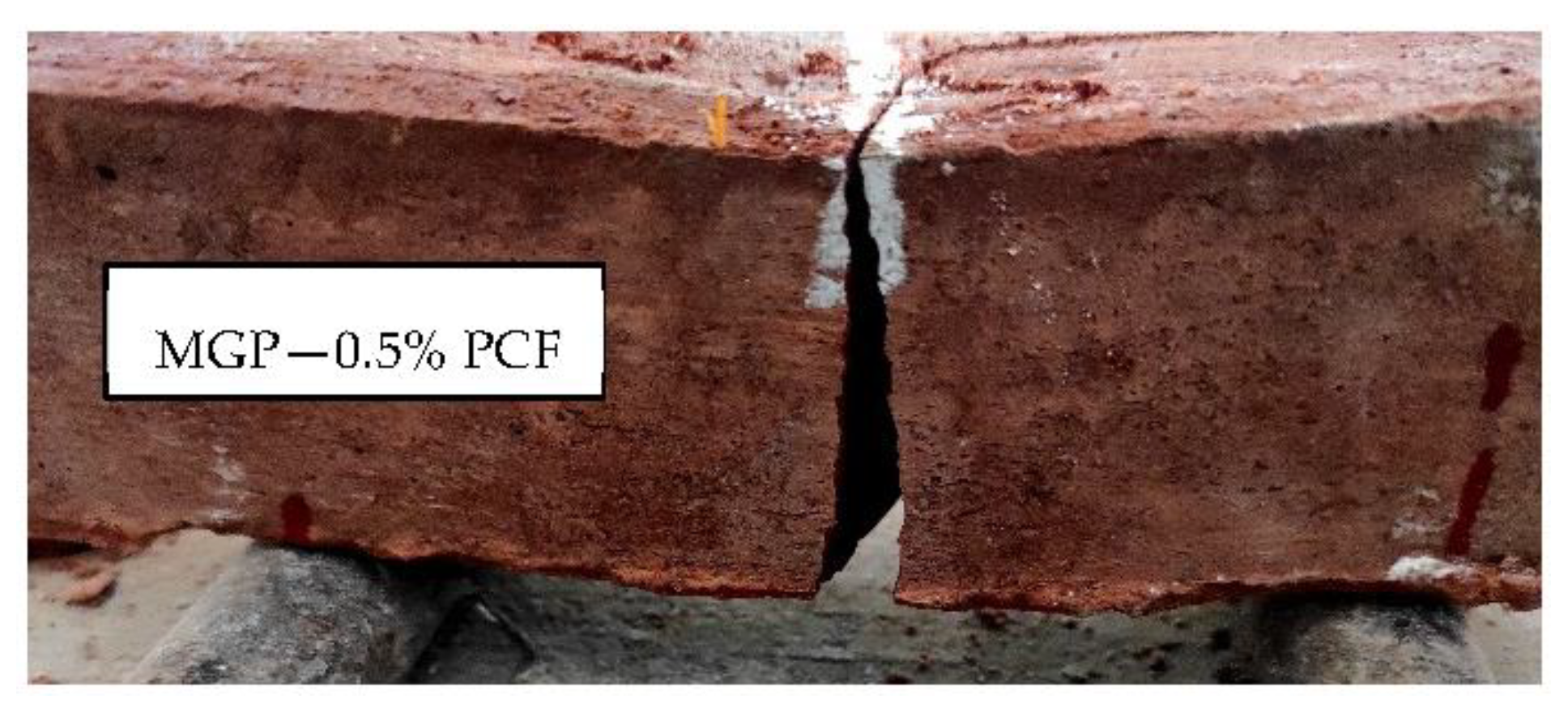
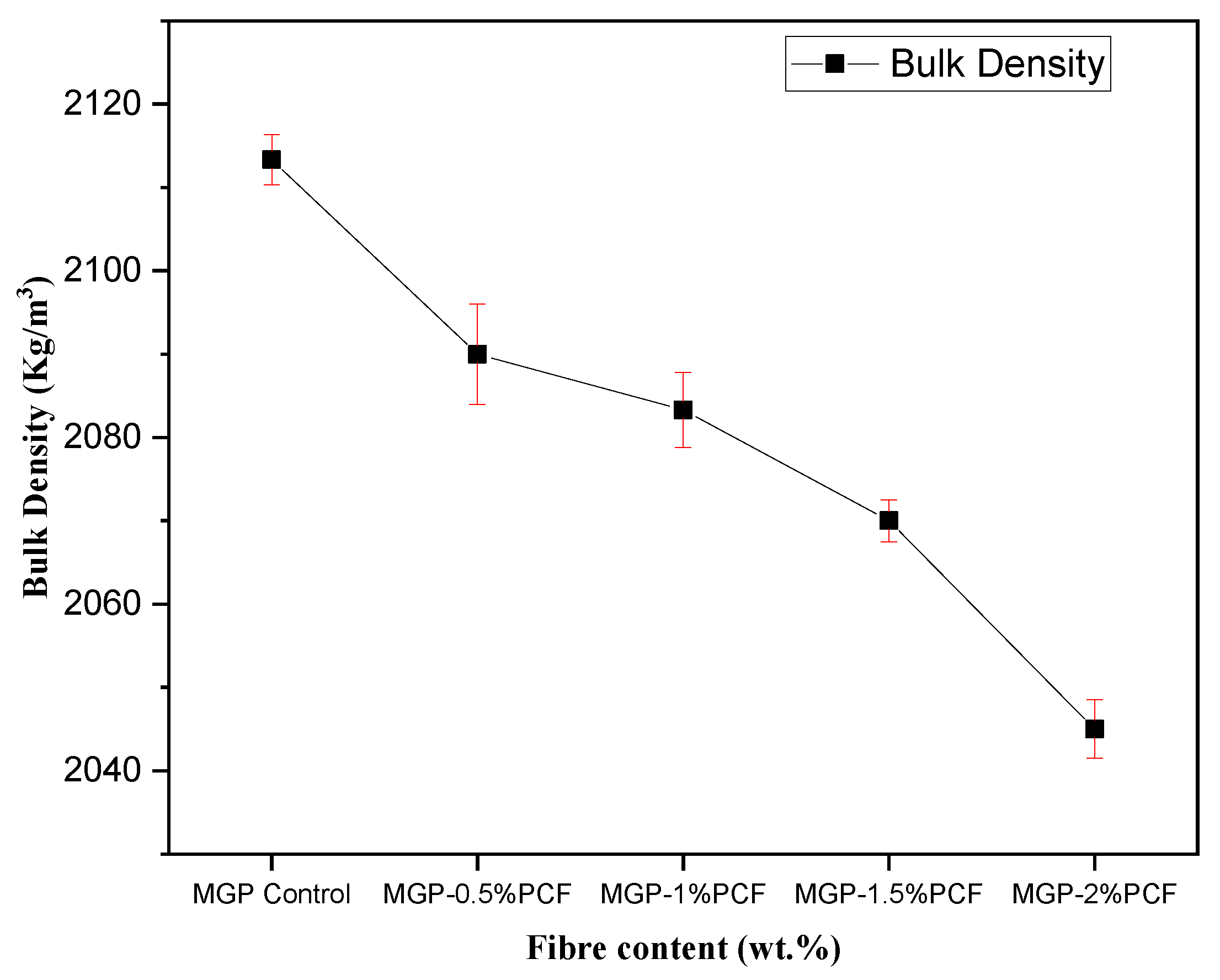
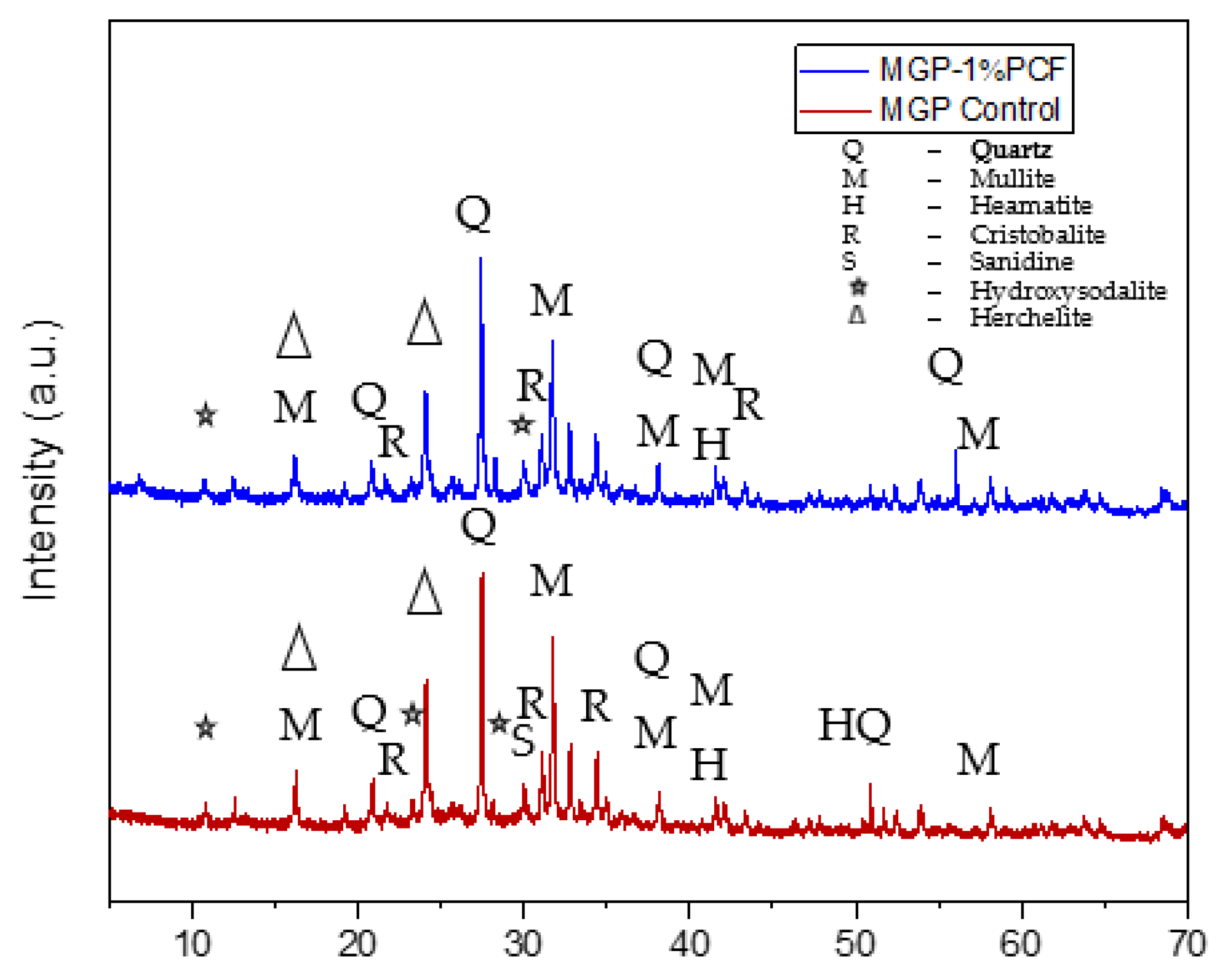
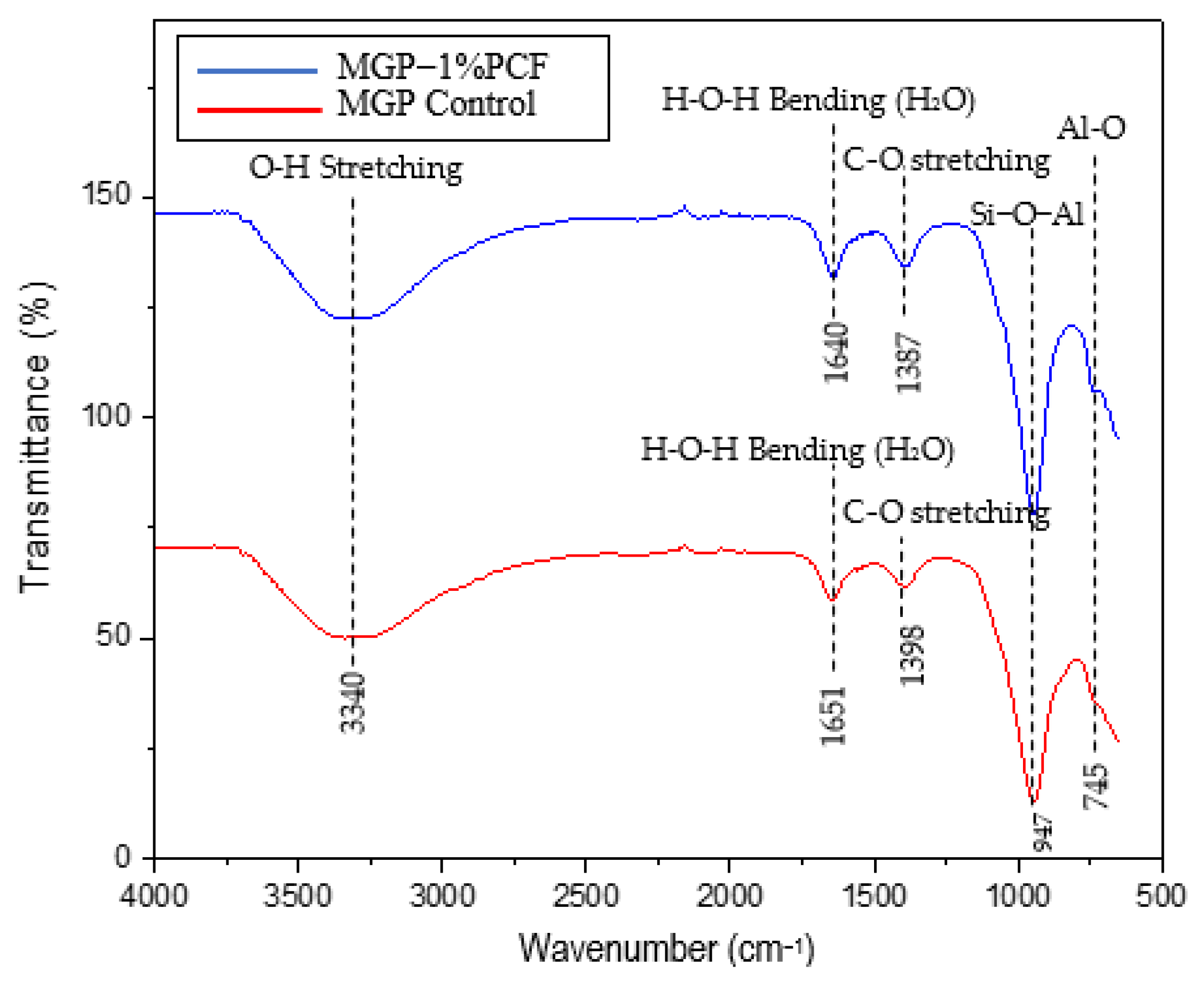
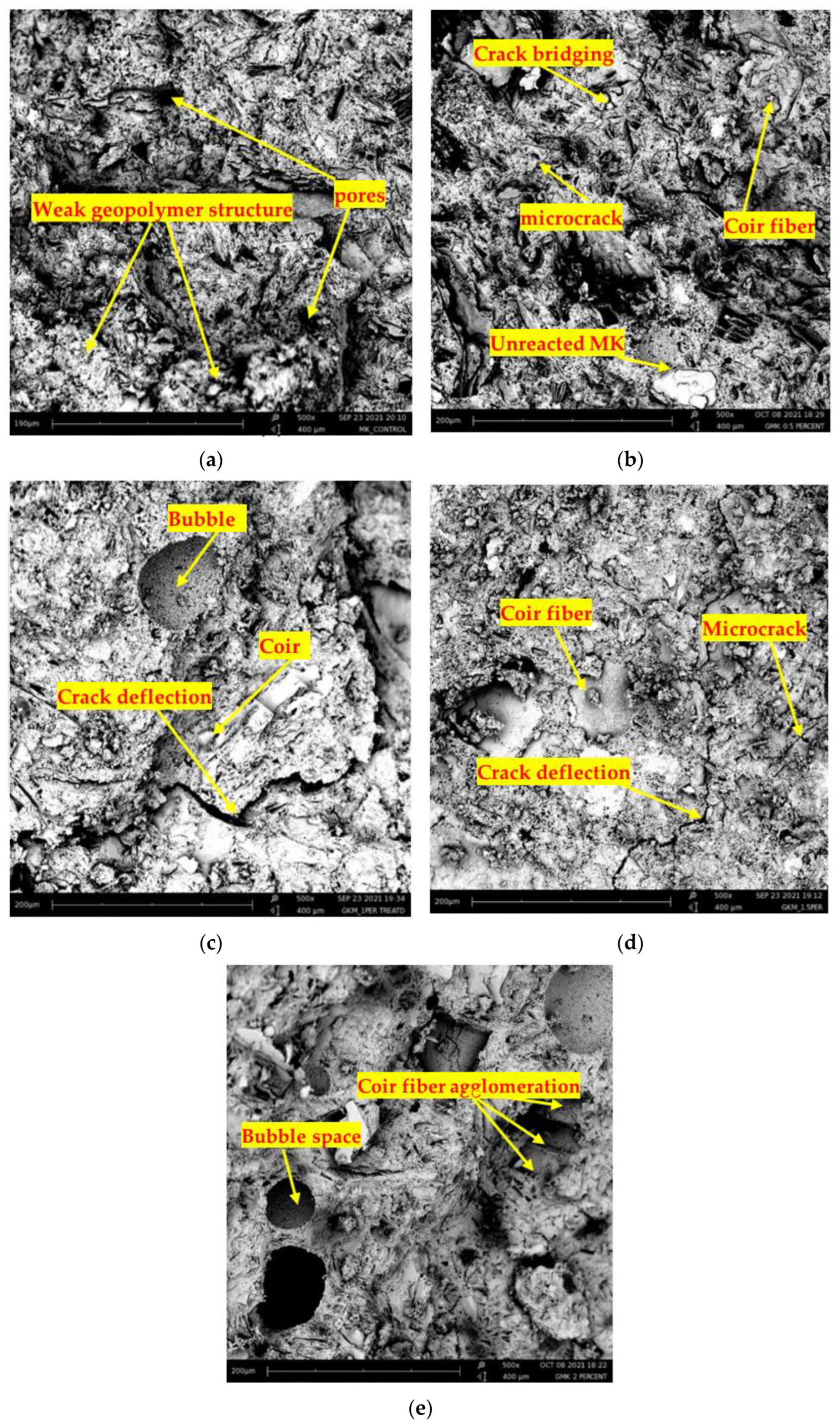
| Mass Ratio (%) | SiO2 | Al2O3 | Fe2O3 | TiO2 | K2O | MnO | ZrO2 | CaO | BaO | LOI |
|---|---|---|---|---|---|---|---|---|---|---|
| Kaolin | 60.09 | 26.15 | 1.46 | 0.27 | 0.70 | 0.20 | 0.01 | 0.06 | 0.21 | 10.85 |
| MK | 60.50 | 34.30 | 2.41 | 0.15 | 0.20 | 0.15 | 0.09 | 0.04 | 0.01 | 2.15 |
| Property | Value |
|---|---|
| Diameter (mm) | 0.35 |
| Tensile strength (MPa) | 138 |
| Young’s modulus (GPa) | 6.2 |
| Elongation at break (%) | 27 |
| Density (g/cm3) | 1.25 |
| Chemical Composition | Untreated Coir Fiber (%) | Pre-Treated Coir Fiber (%) |
|---|---|---|
| Cellulose | 27.0 ± 1.70 | 57.0 ± 1.10 |
| Lignin | 32.80 ± 3.81 | 17.20 ± 1.40 |
| Hemicellulose | 22.50 ± 4.30 | 8.20 ± 1.31 |
| Sample Formulation | MK (g) | Pre-Treated COIR Fiber (PCF) (g) | Na2SiO3/NaOH (by wt.) | Solid/Liquid (S/L) Ratio |
|---|---|---|---|---|
| MGP control | 1200 | 0 | 0.24 | 0.97 |
| MGP—0.5% PCF | 1194 | 6 | 0.24 | 0.97 |
| MGP—1% PCF | 1188 | 12 | 0.24 | 0.97 |
| MGP—1.5% PCF | 1182 | 18 | 0.24 | 0.97 |
| MGP—2% PCF | 1176 | 24 | 0.24 | 0.97 |
| S/N | Sample Formulation | Transmission Time (μs) | UPV (m/s) |
|---|---|---|---|
| 1 | MGP control | 21.6 | 2315 |
| 2 | MGP—0.5% PCF | 18.4 | 2717 |
| 3 | MGP—1% PCF | 18.6 | 2688 |
| 4 | MGP—1.5% PCF | 19.4 | 2577 |
| 5 | MGP—2% PCF | 20.2 | 2475 |
Publisher’s Note: MDPI stays neutral with regard to jurisdictional claims in published maps and institutional affiliations. |
© 2022 by the authors. Licensee MDPI, Basel, Switzerland. This article is an open access article distributed under the terms and conditions of the Creative Commons Attribution (CC BY) license (https://creativecommons.org/licenses/by/4.0/).
Share and Cite
Ayeni, O.; Mahamat, A.A.; Bih, N.L.; Stanislas, T.T.; Isah, I.; Savastano Junior, H.; Boakye, E.; Onwualu, A.P. Effect of Coir Fiber Reinforcement on Properties of Metakaolin-Based Geopolymer Composite. Appl. Sci. 2022, 12, 5478. https://doi.org/10.3390/app12115478
Ayeni O, Mahamat AA, Bih NL, Stanislas TT, Isah I, Savastano Junior H, Boakye E, Onwualu AP. Effect of Coir Fiber Reinforcement on Properties of Metakaolin-Based Geopolymer Composite. Applied Sciences. 2022; 12(11):5478. https://doi.org/10.3390/app12115478
Chicago/Turabian StyleAyeni, Olugbenga, Assia Aboubakar Mahamat, Numfor Linda Bih, Tido Tiwa Stanislas, Ibrahim Isah, Holmer Savastano Junior, Emmanuel Boakye, and Azikiwe Peter Onwualu. 2022. "Effect of Coir Fiber Reinforcement on Properties of Metakaolin-Based Geopolymer Composite" Applied Sciences 12, no. 11: 5478. https://doi.org/10.3390/app12115478
APA StyleAyeni, O., Mahamat, A. A., Bih, N. L., Stanislas, T. T., Isah, I., Savastano Junior, H., Boakye, E., & Onwualu, A. P. (2022). Effect of Coir Fiber Reinforcement on Properties of Metakaolin-Based Geopolymer Composite. Applied Sciences, 12(11), 5478. https://doi.org/10.3390/app12115478








